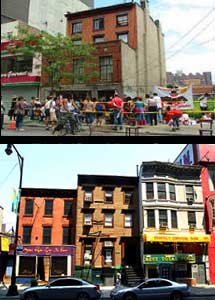
The New York Times published an extensive article on the Underground Railroad in Brooklyn, which explores the Duffield Street homes, and their connection to the rest of Brooklyn at the time. To read the article and see the accompanying video, go to On the Trail of Brooklyn's Underground Railroad
The Times explores some of the context of Duffield Street:
The article mentions the failure to find conclusive proof of Underground Railroad activity:From Plymouth Church, it’s a 10-minute walk to the corner of Fulton and Duffield Streets, where the new Abolitionist Place sign hangs. The abolitionists Thomas and Harriet Truesdell lived at 227 Duffield Street in the 1850s, and William Harned, an Underground Railroad conductor, lived near Duffield and Willoughby Streets.
Even as the city unveiled the new sign, however, it was considering plans to demolish the small houses on Duffield Street as part of an economic development plan for downtown Brooklyn. New hotels, underground parking and a public square would replace much of what now stands on the block.
While maintaining a sense of balance, the article makes a very strong case for further research into the historical significance of the Duffield Street homes.Mr. Greenstein acknowledged that they have only circumstantial evidence. A planning and environmental firm commissioned by the city found no conclusive proof of their claims. The consultants made no attempt to excavate that mysterious tunnel, noting in their report that “assuming that a tunnel was discovered, there would be no way of knowing if it served as a passageway for freedom seekers without corroborating artifacts.”
Still, Mr. Greenstein said, “I think there’s enough evidence here to say, ‘Let’s do an archaeological dig.’”
